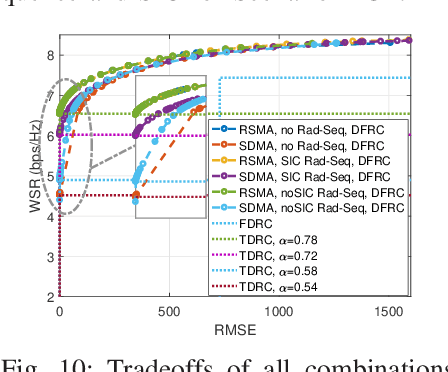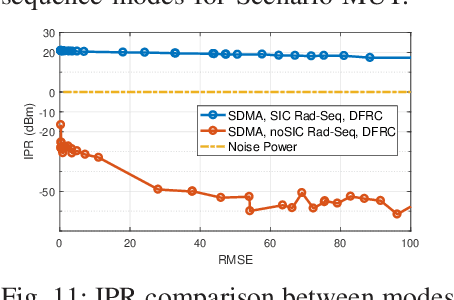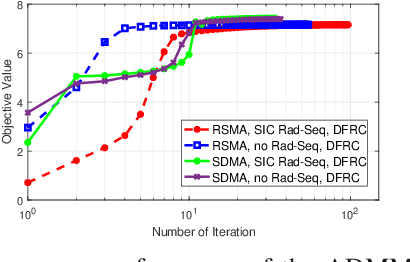Rafael Cerna Loli
Meta-Learning Based Optimization for Large Scale Wireless Systems
Jul 01, 2024Abstract:Optimization algorithms for wireless systems play a fundamental role in improving their performance and efficiency. However, it is known that the complexity of conventional optimization algorithms in the literature often exponentially increases with the number of transmit antennas and communication users in the wireless system. Therefore, in the large scale regime, the astronomically large complexity of these optimization algorithms prohibits their use and prevents assessing large scale wireless systems performance under optimized conditions. To overcome this limitation, this work proposes instead the use of an unsupervised meta-learning based approach to directly perform non-convex optimization at significantly reduced complexity. To demonstrate the effectiveness of the proposed meta-learning based solution, the sum-rate (SR) maximization problem for the following three emerging 6G technologies is contemplated: hierarchical rate-splitting multiple access (H-RSMA), integrated sensing and communication (ISAC), and beyond-diagonal reconfigurable intelligent surfaces (BD-RIS). Through numerical results, it is demonstrated that the proposed meta-learning based optimization framework is able to successfully optimize the performance and also reveal unknown aspects of the operation in the large scale regime for the considered three 6G technologies.
A Meta-Learning Based Precoder Optimization Framework for Rate-Splitting Multiple Access
Jul 17, 2023


Abstract:In this letter, we propose the use of a meta-learning based precoder optimization framework to directly optimize the Rate-Splitting Multiple Access (RSMA) precoders with partial Channel State Information at the Transmitter (CSIT). By exploiting the overfitting of the compact neural network to maximize the explicit Average Sum-Rate (ASR) expression, we effectively bypass the need for any other training data while minimizing the total running time. Numerical results reveal that the meta-learning based solution achieves similar ASR performance to conventional precoder optimization in medium-scale scenarios, and significantly outperforms sub-optimal low complexity precoder algorithms in the large-scale regime.
Hybrid Automatic Repeat Request for Downlink Rate-Splitting Multiple Access
Apr 09, 2023Abstract:This work investigates the design of Hybrid Automatic Repeat Request (HARQ) strategies for downlink Rate-Splitting Multiple Access (RSMA). The existence of private and common stream as well as their conditioning for Successive Interference Cancellation (SIC), gives rise to an expanded set of opportunities for retransmission of failed packets. Specifically, we devise a scheme in which the retransmissions are scheduled through the common stream, which offers a higher success probability. With this, the common stream needs to carry both new and retransmitted bits, which leads to a layered HARQ (L-HARQ) strategy which is capable of trading off throughput and reliability. Simulation results demonstrate that the devised HARQ scheme outperforms RSMA with conventional HARQ, where each retransmission is handled independently through its own stream. It also helps in closing the throughput gap between HARQ and Adaptive Modulation and Coding (AMC) in the high SNR regime while also achieving a decreased Packet Error Rate (PER) and a lower latency.
Model-based Deep Learning Receiver Design for Rate-Splitting Multiple Access
May 02, 2022



Abstract:Effective and adaptive interference management is required in next generation wireless communication systems. To address this challenge, Rate-Splitting Multiple Access (RSMA), relying on multi-antenna rate-splitting (RS) at the transmitter and successive interference cancellation (SIC) at the receivers, has been intensively studied in recent years, albeit mostly under the assumption of perfect Channel State Information at the Receiver (CSIR) and ideal capacity-achieving modulation and coding schemes. To assess its practical performance, benefits, and limits under more realistic conditions, this work proposes a novel design for a practical RSMA receiver based on model-based deep learning (MBDL) methods, which aims to unite the simple structure of the conventional SIC receiver and the robustness and model agnosticism of deep learning techniques. The MBDL receiver is evaluated in terms of uncoded Symbol Error Rate (SER), throughput performance through Link-Level Simulations (LLS), and average training overhead. Also, a comparison with the SIC receiver, with perfect and imperfect CSIR, is given. Results reveal that the MBDL outperforms by a significant margin the SIC receiver with imperfect CSIR, due to its ability to generate on demand non-linear symbol detection boundaries in a pure data-driven manner.
Rate-Splitting Multiple Access for Multi-Antenna Joint Radar and Communications with Partial CSIT: Precoder Optimization and Link-Level Simulations
Jan 25, 2022



Abstract:Dual-Functional Radar-Communication (DFRC) systems have been investigated to manage the inter-system interference between radar and communication systems. However, the studies in literature often assume that the DFRC possesses perfect Channel State Information at the Transmitter (CSIT), which is an unrealistic assumption due to the inevitable CSIT errors in practical deployments. In this work, we aim to design a DFRC system under the practical assumption of partial CSIT. To achieve this, the proposed DFRC marries the capabilities of a Multiple-Input Multiple-Output (MIMO) radar with Rate-Splitting Multiple Access (RSMA). RSMA is a powerful downlink communication scheme based on linearly precoded Rate-Splitting (RS) that partially decodes multi-user interference (MUI) and partially treats it as noise and is inherently robust to partial CSIT. Using RSMA, the DFRC precoders are optimized in the presence of partial CSIT to simultaneously maximize the Average Weighted Sum-Rate (AWSR) under Quality-of-Service (QoS) constraints and minimize the DFRC beampattern Mean Squared Error (MSE) against an ideal MIMO radar beampattern. Simulation results demonstrate that the RSMA-based DFRC largely outperforms DFRCs based on other commonly used strategies such as Space Division Multiple Access (SDMA) and Non-Orthogonal Multiple Access (NOMA). Specifically, the common stream unique in the RSMA-based DFRC allows for flexible rate partitioning to guarantee user rate fairness with partial CSIT while also being the main contributor to generating a directional beampattern for effective radar sensing. The practical performance of the DFRC is then further assessed through Link-Level simulations (LLS) to take into account the effects of coding and modulation in the finite length regime as well as the channel aging due to mobility and latency, where the superiority of RSMA is again corroborated.
 Add to Chrome
Add to Chrome Add to Firefox
Add to Firefox Add to Edge
Add to Edge